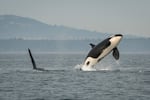
A female southern resident orca breaches the water near the San Juan Islands off the coast of Washington in this 2018 file photo. The southern resident orcas may soon gain added protection off the Oregon Coast with the help of the Oregon Fish and Wildlife Commission. The commission has voted to advance a petition to add the orcas to the state's endangered species list.
NOAA Fisheries / KATY LAVECK FOSTER
A group of killer whales that live in the coastal waters of Oregon and other parts of the Pacific Northwest may soon be listed under the Oregon Endangered Species Act.
The Oregon Fish and Wildlife Commission has voted to advance a petition to protect what are known as the Southern Resident Killer Whales (SRKW.) They consist of three pods numbering 73 orcas, down from almost a hundred in 1994.
Quinn Read is with the Center for Biological Diversity, which recently joined two other groups, Defenders of Wildlife and Whale and Dolphin Conservation, in petitioning the ODFW. She told KLCC that several factors are behind the decline.
“First and foremost for these orcas, they’re at risk for starvation,” said Read. “This population depends on large part on Chinook salmon. And because Chinook themselves are endangered, it just has that impact down the line where the orcas just don’t have enough to eat.”

Chart showing numbers of SRKW between 1960 and 2020. The "A" period refers to when killer whales were largely captured for marine parks, while "B" is for more recent factors including water pollution, inbreeding, vessel traffic, and decline of prey (namely the Chinook salmon.)
Oregon Dept. of Fish and Wildlife
The earliest listed threat to orca numbers was the capture of many in the 1960s for marine parks. More recent threats include pollution, vessel traffic and noise, and inbreeding.
Read said the SRKW are well known in the San Juan Islands and Salish Sea of Canada and Washington.
“What’s less known is that they are just as much an Oregon species. They absolutely come down and forage for fish in the mouth of the Columbia and along the coast, and forage all the way down to Monterey Bay,” she said. “So this is absolutely a species that is resident to Oregon.”
The Commission will now hold a public rulemaking process before deciding whether to protect the orcas under Oregon state law. The ODFW will also consult with affected agencies, Native American tribes, and organizations. The process will take months.
In a release, the ODFW says the SRKW is already listed on the federal Endangered Species Act, as well as Washington state’s ESA.